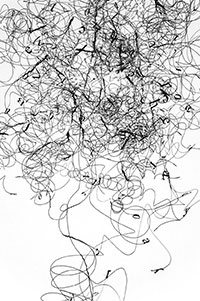 *
*
When I visited the Vernon Street Studios in Somerville for an open house I came across the artwork of Jocelyn Shu. Shu is an eclectic woman, and in addition to creating art, she is a post -doc researcher at Harvard University. She says her art does not explain, but offers the viewer a chance for discovery. Shu exudes a lot of energy, and we had a chance to chat about her confluence of art and science.
Doug Holder: First off, how has it been for you at the Vernon Street Studios?
Jocelyn Shu: I love having a studio here! I’ve been in the building for three years. I found a space here shortly after moving to Cambridge in the fall of 2019 to start a postdoc position at Harvard, and in this time, being a part of Vernon Street Studios has given me the opportunity to be part of a vibrant, creative community. It has been wonderful to have studio visits and develop friendships with fellow artists here, and to meet the surrounding community of artists and art enthusiasts – such as yourself – through the well-attended open studios at this building.
DH: You have a PhD from Columbia University, as well as a BFA in painting and drawing. How does your studies in psychology inform your art?
JS: Since I was a child, I wanted to be an artist and in college, I primarily studied painting and drawing through a joint program with the University of San Francisco and California College of the Arts. I found that art school fostered a great deal of intellectual curiosity – it was also academically formative for me to be at two different kinds of educational environments – and I came out of undergrad wanting to engage in a deeper level of academic discourse to understand the human mind.
I eventually moved to New York City, began studying psychology and working in research labs, then completed a PhD in psychology at Columbia where I conducted basic research on emotions and emotion regulation. Currently, I think psychology informs my art at a more unconscious level. I can see in both my work in science and art, an interest in language and how we cope with uncertainty and change. People often find my sculptural pieces to resemble neurons – that is not something I intended in my art, but I think it is also not a pure coincidence.
DH: I asked you at your studio, “What is the theory of your work?” You seemed to find that an interesting question. So what is the “theory?”
JS: I thought it was an interesting question as it melds language and thinking from science and art. From the scientific side, a theory is an explanation of how something in the world works. At this time, I don’t think I can translate that directly into my art practice – my art doesn’t seek to explain. Instead, like a lot of art, it seeks to open viewers’ minds to different ideas, possibilities, and emotional experiences. That said, there are broad themes that I’m drawn to in my art practice – the disassembling of language and thought, line, change, beauty.
DH: I have interviewed a number of art therapists over the year. Do you use art in your own practice?
JS: I’m trained as a basic researcher and don’t have experience as a clinician or therapist. However, I have been interested in studying how art can help us manage our emotions, a topic that could inform understanding of why art therapy is effective. As a postdoctoral researcher, I’ve started to conduct some studies that are addressing these questions.
DH: One piece I saw of yours seemed to be a mesh of thin threads – attached to neuron-like images. It seemed to be a network. Can you explain what you were trying to get across?
JS: I think you might be referring to one of my sculptural pieces made of wire, as some of this work takes neuron-like forms. If so, the piece would have been part of a series I’ve been working on for over ten years in which I’ve been cutting text from translated chapters of the Dao De Jing – Chinese philosophical text – and attaching the text to wire to form sculptural pieces that hang from the ceiling and walls, and sit on the ground. In this work, I consider the acts of crossing cultures, and of translating and taking apart language. More recently, these pieces have become more autobiographical as I incorporate found materials from my environment into them.
DH: Any upcoming projects, showings?
JS: I’m just about to move to Taipei, Taiwan, where my parents are from and where I plan to spend most of the upcoming year. This is the first time I’ll be living there for an extended period of time and while I’ll continue to work on ongoing research in psychology, I intend to focus on my art practice now. I’m curious how this experience might lead to new bodies of work as I learn the language and navigate cultural differences. I will keep my studio space at Vernon Street Studios and plan to be back for a solo show at the Launchpad space at Boston Sculptors Gallery in October 2023.















Reader Comments